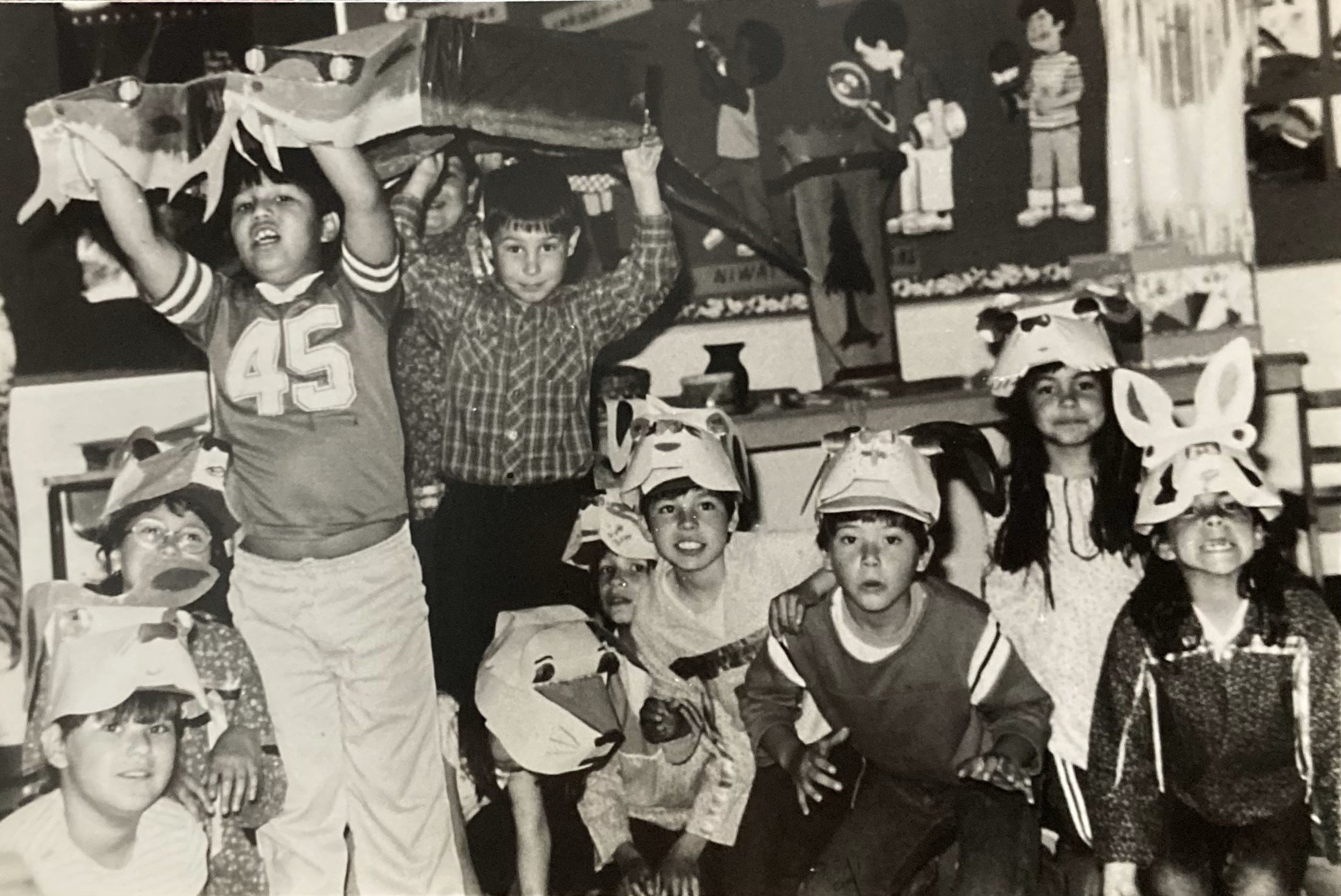Why we have so many dogs in Kahnawake
Illustration by Rita Phillips
Story told by Kaia’titákhe Jacobs
At that time, dogs were loose. They ran all over town and got into all kinds of trouble.
The people in the community got tired of these dogs barking all night and doing all this mischief. They went to see the chief and said, “Something’s gotta be done about these dogs! We can’t just let them run around free like this, causing all kinds of trouble.”
The chief says, “Well, what should we do?”
“We’re gonna have to hunt them down.”
So, that was the plan.
This old man living on a farm heard about what was going on in town.
He said, “Takì:ten! Pity me! Iah tehonaterién:tare ’ oh nihontiéhrha’! Those people don’t know what they’re doing!”
So, he made the trek to town. He went to a platform in front of the church where people could stand if they had anything important to share with the community.
He stood on the platform, and people started coming around to listen to what the message was.
He said, “Tewataté:ken! Brothers! Iah teioiánere’ tsi nisewaierá:ne’! What you’re doing is not good!
“Don’t you know that those dogs are here for a purpose? They’re doing their jobs, and you cannot do what you’re planning to do. You know that in this great river that’s passing us by, there is a sea creature that lives at the bottom of that river and is trying to come up onto our shores to take over our town. Those dogs are there working all night, barking to keep the serpent at bay.”
The people didn’t say another word and slowly left for home.
And that’s why we still have so many dogs in Kahnawake.
Tsi nón:tieren ionkwanahskwakà:te ne è:rhar Kahnawà:ke
Courtesy: Kaia’titáhkhe Jacobs
Kaia’titákhe Jacobs iakoká:raton
Tho shontakahá:wi’, ok thikontatewenní:io ne è:rhar. Kwah kanatakwé:kon thikontitakhenóntie’s kí:ken è:rhar tánon’ nia’té:kon wa’kontéron’onhte’. Wahotihswà:ten’ onkwehshòn:’a kaná:takon ase’kén ahsontakwé:kon iotihniià:tskon kí:ken è:rhar tánon’ tsi nikonteron’ónhtha’. Wahshakonatken’sè:ra’ ne roiá:ner tánon’ wahonnì:ron’, “Entà:’on ok nenkaié:ren kí:ken e’rhar’ó:kon! Iah nek thaón:ton’ aiethiríhon’ ka’ tsi’k nón:we akontitakhenontiè:sheke’ kontatewenní:io. Roiá:ner tontahèn:ron’, “Hátskwi, oh káti’ naietewá:iere’? “Tenwatonhóntsohwe’ aiethiiatorátha’.” Né: ká:ti’, tho né: nikanonio’ténhne’. Kí:ken rokstén:ha kahehtà:ke thèn:teron waharihwà:ronke’ tsi nitiawenhátie’ kaná:takon. Wahèn:ron’, Takì:tenr! Iah tehonaterièn:tare’ oh nihontiéhrha’! Né: ká:ti’, wahathahíta’, kaná:takon iahatié:ra’te’. Tho iahà:re’ tsi nón: niwahskwáhskwahere ohén:ton nonkwá:ti tsi ionterennaientáhkhwa’, tsi nón: ón:kwe ia’tenié:ta’ne’ tóka’ othé:nen iorihowá:nen iakorì:waien ahonwatirihowanáhten’ onkwe’tà:ke. Tsi wahskwáhere ia’thá:ta’ne’, tánon’ onkwehshòn:’a tahonatia’torohronhátie’ tsi nahò:ten’ enharihwakè:ron’. Wahèn:ron’, “Tewatatè:ken! Iah teioiánere’ tsi nisewaierà:ne’! “Iah ken tesewaterièn:tare’ oh nahò:ten’ kontinién:te kí:ken è:rhar? Iotiió’te’ nahò:ten’ ionateríhonte’, tánon’ iah thaón:ton’ tho naiesewá:iere’ kí:ken nahò:ten’ sewaten’nikonhrón:ni. Kèn:tho kí:ken kaniatarowá:nen ionkwatohetstonhátie’ nawèn:ke tho tkanákere kí:ken ohniare’kó:wa kanón:wakon tánon’ wate’niénhtha’ atsà:kta akaráthen’ tánon’ taionkwanatakwe’niióhsten’. Thí:ken e’rhar’ó:kon ahsontakwé:kon iotiio’tátie’, iotihní:hen é:ren akonwatè:kwa’te’ nohniare’kó:wa.” Iah tsowén:na shé: tehó:nen nonkwehshòn:’a tánon’ skennen’shòn:’a sahonhtén:ti’. Tánon’ né: tiorì:wa shé:kon tho niionkwanahskwakà:te ne è:rhar Kahnawà:ke.
Edited by: Simona Rosenfield, Local Journalism Initiative Reporter
Translation by Sahawisó:ko’ Arquette


